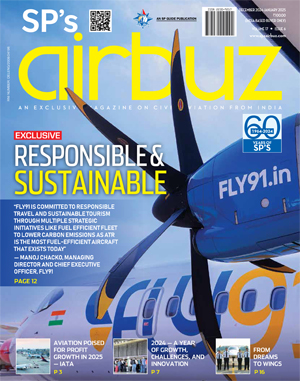Need For Nurturing

Experts believe that regional airlines would be workable only in the long-term when at least 200 cities across the country have functional airports. That would create enough space for everyone. However, the AAI estimates that traffic from non-metro airports is already growing twice as fast as that from the metros and may hit 45 per cent of the total within just five years.
It is a familiar early morning sight at many far-flung airfields in the developed world, especially the United States. Travellers wend their way to a waiting plane lugging their personal belongings. They are prepared to rough it out to a degree because this is only the first short leg of a long journey to a distant destination. The plane, generally a jet, but increasingly a turboprop, has about 50 seats. The regional carrier that operates it is unfazed if some seats remain empty because it has a code-sharing agreement with a major airline and is assured of a fixed profit upon completion of each flight. Code sharing allows major carriers to competitively outsource their flying even while maintaining their brand identity.
Who benefits? Code-sharing agreements streamline the flying experience for the traveller and provide seamless service to small, remote communities. Consumers benefit from lower ticket prices and enjoy more air travel options. From the point of view of the major airlines, a steady stream of passengers is available to feed their national and international networks. Operationally, the practice allows individual carriers to specialise in a particular aircraft and follow a single business model, which greatly simplifies things. Although the system has recently come under some strain, it generally works. That is why in the US for instance, regional airlines serve a whopping 681 communities and 70 per cent of those communities are only served by regional carriers. And across the globe, regional airlines are the only means by which hundreds of towns and small cities are connected by air.
Cold Start
It is a different story in India where dedicated regional operators are conspicuous by their absence. The government’s ambitious August 2007 policy on scheduled regional air transport operations has practically drawn a blank. Some experts blame its strict fleet size norms and other stringent preconditions for this sorry state of affairs. In the absence of regional airlines, it falls to the mainline carriers to operate a handful of flights to regional airports. Sadly, commercial aviation remains fascinated by big-city lights and almost 70 per cent of domestic passenger traffic passes through the six metros. Even exquisite tourist and religious spots such as Mysore and Puducherry find it difficult to attract scheduled air services.
Regional aviation has of necessity to be undertaken by smaller aircraft since just a third of the country’s airports can accept even narrow-body aircraft like the Airbus A320 and the Boeing B737. A big incentive for regional flights in India is that aircraft weighing up to 40,000 kg are supplied aviation turbine fuel (ATF) at sales tax of just four per cent against an average of 24 per cent for heavier aircraft. Similarly, landing and parking charges are waived for aircraft that carry up to 80 passengers. However, these concessions are applicable to all airlines, not just regional carriers. Therefore, large and small airlines end up competing on the same routes. Before long, the small regional carriers who cannot afford to undercut their big rivals will be priced out of the market.
The Wrong Way
Coercion comes easy to officialdom. Having failed to encourage small regional airlines to launch services, the Indian Government appears to be gearing up to compel the existing airlines to increase their flights to smaller cities. The deeply unpopular route dispersal guidelines already oblige the major carriers to operate to the Northeast region, Jammu and Kashmir, Andaman and Nicobar, and Lakshadweep islands; but these have met with mixed success. The latest proposal is to include more cities in Category II routes so as to give the airlines a wider choice of less attractive destinations to fly to. However, major airlines that operate large aircraft on international routes may not find it easy to downscale and operate smaller aircraft to out-of-the-way destinations. And forcing airlines to service airports that do not fit in with their business plan is hardly helpful.
SpiceJet, which earlier had only Boeing B737 jets, is the main carrier currently bringing air connectivity to smaller cities such as Hubli and Belgaum with the help of 12 Bombardier Q400 NextGen turboprop aircraft. Jet Airways has 20 ATR 72-500 turboprops suitable for regional operations. But IndiGo and GoAir have the all-Airbus A320-200 fleet and cannot use short runways. They are also fairly uneconomical on short-haul routes. Air India’s forays into dedicated regional operations (via the erstwhile Vayudoot and some Indian Airlines flights) were a failure. Kingfisher Airlines seems ready to go under. How can these carriers boost regional aviation?
The government’s ‘solution’ is a new aircraft-acquisition policy intended to ‘persuade’ the airlines to buy smaller planes and increase flights to smaller cities. However, the airlines naturally are reluctant to sacrifice their freedom to purchase aircraft of their choice. Why should any carrier be forced to compromise its economical singletype fleet and go in for a mix of aircraft which multiplies operational, maintenance, training and administrative problems? Sensing the emerging opposition, the government now says that the recently reconstituted Aircraft Acquisition Committee would merely ask an airline to provide a firm business plan before ordering new aircraft so as to not let it fall prey to overcapacity. It sounds good in theory. But does the government have sufficient expertise to evaluate an airline’s business plan? If it had, its own carrier, Air India might not have been in such dire straits today.
A Helping Hand Helps
At the heart of the regional aviation riddle is the fact that inter-state connectivity is much better than short-haul intra-state connectivity. Aviation infrastructure can improve much faster when local governments chip in to hasten land acquisition procedures and expedite the plethora of necessary clearances. Some enlightened state governments are indeed beginning to offer tax concessions and financial support in an effort to encourage entrepreneurs to launch operations within their states.
Experience from around the globe suggests that regional services often need nurturing by subsidies or tax breaks. In the US, the Essential Air Service subsidy was introduced in 1978 to help regional airlines provide services to small, isolated and far-flung communities that no major airline wanted to touch. In India, the creation of an Essential Air Services Fund (EASF) for subsidising loss-making routes connecting smaller airports is under consideration. The aim would be to auction commercially unviable routes that attract lower passenger numbers for three to five years till they reach some level of maturity.
Regional airlines can succeed only if based on the low-cost, low-fare model and by operating as feeder services to the mainline carriers. On low-density regional routes, it makes sense to deploy turboprops rather than jets, especially in the prevailing situation of high fuel prices. Hence, official policy needs to be directed at incentivising small companies to induct turboprops and operate them on short-haul routes, while the bigger ones operate jets on longer routes. Both should be encouraged to cooperate on different routes rather than compete on the same ones by various methods, including code sharing.
The Ministry of Civil Aviation is reportedly working on a sensible plan to allow non-scheduled carriers to enter into codeshare agreements with scheduled airlines. The non-scheduled ones could act as feeder services for the scheduled carriers. However, success depends on the willingness of the charter operators to rework their economics and join such a venture.





